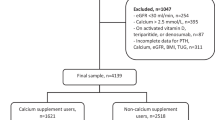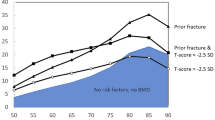Abstract
Summary
Approximately half of individuals with hypophosphatasemia (low levels of serum alkaline phosphatase) have hypophosphatasia, a rare genetic disease in which patients may have stress fractures, bone and joint pain, or premature tooth loss. We developed a predictive model based on specific biomarkers of this disease to better diagnose this condition.
Introduction
Hypophosphatasemia is a condition in which low levels of alkaline phosphatase (ALP) are detected in the serum. Some individuals presenting with this condition may have a rare genetic disease called hypophosphatasia (HPP), which involves mineralization of the bone and teeth. Lack of awareness of HPP and its nonspecific symptoms make this genetic disease difficult to diagnose. We developed a predictive model based on biomarkers of HPP such as ALP and pyridoxal 5′-phosphate (PLP), because clinical manifestations sometimes are not recognized as symptoms of HPP.
Methods
We assessed 325,000 ALP results between 2010 and 2015 to identify individuals suspected of having HPP. We performed univariate and multivariate analyses to characterize the relationship between hypophosphatasemia and HPP. Using several machine learning algorithms, we developed several models based on biomarkers and compared their performance to determine the best model.
Results
The final cohort included 45 patients who underwent a genetic test. Half (23 patients) showed a mutation of the ALPL gene that encodes the tissue-nonspecific ALP enzyme. ALP (odds ratio [OR] 0.61, 95% confidence interval [CI] 0.3–0.8, p = 0.01) and PLP (OR 1.06, 95% CI 1.01–1.15, p = 0.04) were the only variables significantly associated with the presence of HPP. Support vector machines and logistic regression were the machine learning algorithms that provided the best predictive models in terms of classification (area under the curve 0.936 and 0.844, respectively).
Conclusions
Given the high probability of a misdiagnosis, its nonspecific symptoms, and a lack of awareness of serum ALP levels, it is difficult to make a clinical diagnosis of HPP. Predictive models based on biomarkers are necessary to achieve a proper diagnosis. Our proposed machine learning approaches achieved reasonable performance compared to traditional statistical methods used in biomedicine, increasing the likelihood of properly diagnosing such a rare disease as HPP.




Similar content being viewed by others
Data availability
According to the terms of a contract signed with Mostoles University Hospital, which provided the data set, we cannot provide our data set to any other researcher. Furthermore, we destroyed the data set at the conclusion of our investigation.
References
McKiernan FE, Berg RL, Fuehrer J (2014) Clinical and radiographic findings in adults with persistent hypophosphatasemia. J bone Miner Res. 29(7):1651–1660
McKiernan FE, Dong J, Berg RL, Scotty E, Mundt P, Larson L et al (2017) Mutational and biochemical findings in adults with persistent hypophosphatasemia. Osteoporos Int. 28(8):2343–2348
Millan JL, Whyte MP (2016 Apr) Alkaline phosphatase and hypophosphatasia. Calcif Tissue Int. 98(4):398–416
Whyte MP (2009 Jun) Atypical femoral fractures, bisphosphonates, and adult hypophosphatasia. J Bone Miner Res. 24(6):1132–1134
Bianchi ML (2015 Dec) Hypophosphatasia: an overview of the disease and its treatment. Osteoporos Int. 26(12):2743–2757
Riancho-Zarrabeitia L, Garcia-Unzueta M, Tenorio JA, Gomez-Gerique JA, Ruiz Perez VL, Heath KE et al (2016 Apr) Clinical, biochemical and genetic spectrum of low alkaline phosphatase levels in adults. Eur J Intern Med. 29:40–45
Mornet E, Yvard A, Taillandier A, Fauvert D, Simon-Bouy B (2011) A molecular-based estimation of the prevalence of hypophosphatasia in the European population. Ann Hum Genet. 75(3):439–445
Leung ECW, Mhanni AA, Reed M, Whyte MP, Landy H, Greenberg CR (2013) Outcome of perinatal hypophosphatasia in manitoba mennonites: a retrospective cohort analysis. JIMD Rep. 11:73–78
Berkseth KE, Tebben PJ, Drake MT, Hefferan TE, Jewison DE, Wermers RA (2013 May) Clinical spectrum of hypophosphatasia diagnosed in adults. Bone. 54(1):21–27
Mornet E (2007) The Tissue Nonspecific Alkaline Phosphatase Gene Mutations Database:2017
Tenorio J, Álvarez I, Riancho-Zarrabeitia L, Martos-Moreno GÁ, Mandrile G, de la Flor CM et al (2017 Mar) Molecular and clinical analysis of ALPL in a cohort of patients with suspicion of Hypophosphatasia. Am J Med Genet A. 173(3):601–610
The Tissue Nonspecific Alkaline Phosphatase Gene Mutations Database [Internet]. [cited 2020 Mar 31]. Available from: http://www.sesep.uvsq.fr/03_hypo_mutations.php
R Core Team. R: a language and environment for statistical computing [Internet]. Vienna, Austria; 2020. Available from: https://www.r-project.org/
Bland JM, Altman DG. The odds ratio. BMJ [Internet]. 2000 May 27;320(7247):1468. Available from: http://www.bmj.com/content/320/7247/1468.1.abstract
Beam AL, Kohane IS (2018 Apr) Big data and machine learning in health care. JAMA. 319(13):1317–1318
Obermeyer Z, Emanuel EJ (2016 Sep) Predicting the future - big data, machine learning, and clinical medicine. N Engl J Med. 375(13):1216–1219
Weber GM, Mandl KD, Kohane IS (2014 Jun) Finding the missing link for big biomedical data. JAMA. 311(24):2479–2480
Liaw A, Wiener M (2002) Classification and regression by randomForest. R News. 2(3):18–22
Meyer D, Dimitriadou E, Hornik K, Weingessel A, Leisch F. e1071: Misc Functions of the Department of Statistics, Probability Theory Group (Formerly: E1071), TU Wien [Internet]. 2017. Available from: https://cran.r-project.org/package = e1071
Cover T, Hart P (1967) Nearest neighbor pattern classification. IEEE Trans Inf Theory. 13(1):21–27
Katz MH. Multivariable analysis: a practical guide for clinicians and public health researchers. Cambridge university press; 2011.
Wiest MM, Lee KJ, Carlin JB (2015) Statistics for clinicians: an introduction to logistic regression. J Paediatr Child Health. 51(7):670–673
Anderson RP, Jin R, Grunkemeier GL (2003) Understanding logistic regression analysis in clinical reports: an introduction. Ann Thorac Surg. 75(3):753–757
Bagley SC, White H, Golomb BA (2001) Logistic regression in the medical literature: standards for use and reporting, with particular attention to one medical domain. J Clin Epidemiol. 54(10):979–985
Kuhn M, Johnson K. Applied predictive modeling. Applied Predictive Modeling. 2013. p. 1–600.
Kuhn M. caret: Classification and regression training. 2020.
Fleiss JL, Levin B, Paik MC. Statistical methods for rates and proportions. John Wiley & Sons; 2013.
Sing T, Sander O, Beerenwinkel N, Lengauer T (2005 Oct) ROCR: visualizing classifier performance in R. Bioinformatics. 21(20):3940–3941
Khan AA, Josse R, Kannu P, Villeneuve J, Paul T, Van Uum S et al (2019 Sep) Hypophosphatasia: Canadian update on diagnosis and management. Osteoporos Int. 30(9):1713–1722
Maman E, Borderie D, Roux C, Briot K (2016 Mar) Absence of recognition of low alkaline phosphatase level in a tertiary care hospital. Osteoporos Int. 27(3):1251–1254
Whyte MP (2017 Sep) Hypophosphatasia: an overview for 2017. Bone. 102:15–25
García-Fontana C, Villa-Suárez JM, Andújar-Vera F, González-Salvatierra S, Martínez-Navajas G, Real PJ, Gómez Vida JM, de Haro T, García-Fontana B, Muñoz-Torres M (2019 Jul) Epidemiological, clinical and genetic study of hypophosphatasia in a Spanish population: identification of two novel mutations in the Alpl gene. Sci Rep. 9(1):9569
Tornero C, Navarro-Compán V, Tenorio JA, García-Carazo S, Buño A, Monjo I, Plasencia-Rodriguez C, Iturzaeta JM, Lapunzina P, Heath KE, Balsa A, Aguado P (2020 Feb) Can we identify individuals with an ALPL variant in adults with persistent hypophosphatasaemia? Orphanet J Rare Dis. 15(1):51
Whyte MP (2016) Hypophosphatasia—aetiology, nosology, pathogenesis, diagnosis and treatment. Nat Rev Endocrinol. 12(4):233–246
Vinan-Vega MN, Abate EG (2018) Hypophosphatasia: clinical assessment and management in the adult patient - a narrative review. Endocr Pract. 24(12):1086–1092
Mornet E (2018) Hypophosphatasia. Metabolism 82:142–155
Choida V, Bubbear JS. Update on the management of hypophosphatasia. Ther Adv Musculoskelet Dis. 2019;11:1759720X19863997.
Gagnon C, Sims NA, Mumm S, McAuley SA, Jung C, Poulton IJ et al (2010 Mar) Lack of sustained response to teriparatide in a patient with adult hypophosphatasia. J Clin Endocrinol Metab. 95(3):1007–1012
Seefried L, Baumann J, Hemsley S, Hofmann C, Kunstmann E, Kiese B, Huang Y, Chivers S, Valentin MA, Borah B, Roubenoff R, Junker U, Jakob F (2017 Jun) Efficacy of anti-sclerostin monoclonal antibody BPS804 in adult patients with hypophosphatasia. J Clin Invest. 127(6):2148–2158
Whyte MP (2017 Apr) Hypophosphatasia: enzyme replacement therapy brings new opportunities and new challenges. J bone Miner Res Off J Am Soc Bone Miner Res. 32(4):667–675
Garcia-Carretero R, Vigil-Medina L, Barquero-Perez O, Ramos-Lopez J (2019 Dec) Pulse wave velocity and machine learning to predict cardiovascular outcomes in prediabetic and diabetic populations. J Med Syst. 44(1):16
Robinson GA, Peng J, Dönnes P, Coelewij L, Naja M, Radziszewska A, Wincup C, Peckham H, Isenberg DA, Ioannou Y, Pineda-Torra I, Ciurtin C, Jury EC (2020) Disease-associated and patient-specific immune cell signatures in juvenile-onset systemic lupus erythematosus: patient stratification using a machine-learning approach. Lancet Rheumatol. 2(8):e485–e496
Schaefer J, Lehne M, Schepers J, Prasser F, Thun S (2020) The use of machine learning in rare diseases: a scoping review. Orphanet J Rare Dis 15(1)
Acknowledgments
The authors would like to thank Blanca San Jose Montano, the Health Science Librarian-Documentalist at our institution, for her great support, suggestions, and encouragement in the making of this manuscript.
Funding
The authors received no financial support for the research, authorship, and/or publication of this article.
Author information
Authors and Affiliations
Corresponding author
Ethics declarations
Ethics approval and consent to participate
This retrospective research was approved by the Research and Ethics Committee of Mostoles University Hospital. All procedures involving human participants were conducted in accordance with the ethical standards of the responsible institutional and/or national research committee and with the 1964 Helsinki Declaration and its later amendments or comparable ethical standards. The authors obtained consent to publish from their own institution and its Research and Ethics Committee.
Competing interests
None
Additional information
Publisher’s note
Springer Nature remains neutral with regard to jurisdictional claims in published maps and institutional affiliations.
Rights and permissions
About this article
Cite this article
Garcia-Carretero, R., Olid-Velilla, M., Perez-Torrella, D. et al. Predictive modeling of hypophosphatasia based on a case series of adult patients with persistent hypophosphatasemia. Osteoporos Int 32, 1815–1824 (2021). https://doi.org/10.1007/s00198-021-05885-8
Received:
Accepted:
Published:
Issue Date:
DOI: https://doi.org/10.1007/s00198-021-05885-8




